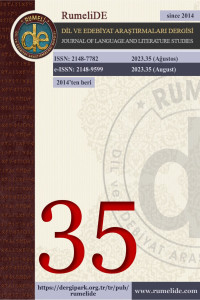Abstract
Bu araştırmada “Klasik ve Romantik dönem eserlerinde piyano eşliğinin solo partiyle olan ilişkisi, eşlik türü açısından hangi çeşitlerde karşımıza çıkar?” sorusuna cevap aranmıştır. Araştırma; C.F. Zelter, W.A. Mozart, L.v. Beethoven, J. Brahms, R. Schumann, F. Chopin ve F. Mendelssohn Bartholdy’den seçilmiş piyano eşliğine sahip 115 eserle sınırlandırılmıştır. Elde edilen bulgular ışığında; 79 eserde soloya bağımlı eşlik kullanıldığı, bu eşlik türüne Romantik döneme göre Klasik dönemde daha fazla yer verildiği; 87 eserde solodan bağımsız eşlik kullanıldığı, bu eşlik türüne Klasik döneme göre Romantik dönemde daha fazla yer verildiği görülmüştür. Klasik dönemde gelişimini sürdüren bir çalgı olarak piyano, soloya bağımlı eşlikle yani soloyu aynı şekilde duyurma göreviyle öne çıkar. Beethoven’ın incelenen tüm eserlerinde piyanoyu bu amaçla görevlendirdiği görülmüştür. Mozart, tüm eserlerinde olmasa da büyük oranda bu eşlik tarzına yer verir. Müziğin, daha duygusal ve kişisel bir ifade arayışına yöneldiği Romantik dönemde, piyano da bu değişime paralel olarak kendine özgü bir karakter geliştirir. Piyano, duygusal ifadenin yoğunlaştığı, klasik dönemdeki sınırlamalardan kurtulmuş ve bestecilerin daha kişisel bir ifade için geniş bir alan bulduğu bir enstrüman haline gelmiştir. Araştırma kapsamında incelenen Romantik dönem eserlerinde bu gelişimin bir yansıması olarak, piyano eşliğinin solodan daha bağımsız melodik hareketlerine yer verilmiştir. Bu genel sonuçla birlikte, Klasik dönemde Zelter’in, Romantik dönemde de Brahms’ın farklı kullanımları görülmüştür.
Keywords
References
- Apel, W. (1950). Harvard dictionary of music. Cambridge: Harvard University Press.
- Artaç, A. (2012). Operaların piyano eşliklerinin yorumlanması. Uludağ Üniversitesi Fen-Edebiyat Fakültesi Sosyal Bilimler Dergisi, 13 (23), 227-242.
- Atterbury, B. W. & Silcox, L. (1993). The effect of piano accompaniment on kindergartners’ developmental singing ability. Journal of Research in Music Education, 41(1), 40-47.
- Bach, J. S. (1860). Bach-Gesellschaft Ausgabe, Band 9. (Ed. Wilhem Rust). Leipzig: Breitkopf und Härtel.
- Beethoven, L. v. (1863). Acht gesänge und lieder, Op. 52. (Ed. Max Unger). Leipzig: Breitkopf und Härtel.
- Beethoven, L. v. (1863). Sechs lieder Op. 48. (Ed. Max Unger). Leipzig: Breitkopf und Härtel.
- Brahms, J. (1926). Lieder und romanzen Op. 14. (Ed. Eusebius Mandyczewski). Leipzig: Breitkopf und Härtel.
- Chopin, F. (1880). Polnische lieder für eine singstimme mit begleitung des pianoforte, Op. 74. (Ed. Gustawa Gebethnera). Leipzig: Breitkopf und Härtel.
- Çalık, M. ve Sözbilir, M. (2014). İçerik analizinin parametreleri. Eğitim ve Bilim, 39 (174), 33-38 doi: 10.15390/EB.2014.3412
- English, W. H. (1985). The relative effectiveness of the amount of piano accompaniment in beginning strings class ınstruction, University of Houston, Doctoral Dissertation, Houston.
- Guelker-Cone, L. (1998). The unaccompanied choral rehearsal. Music Educators Journal. 85(2), 17-22. doi: 10.2307/3399167
- Hale, M. R. (1976). An experimental study of the comparative effectiveness of harmonic and melodic accompaniment in singing as it relates to the development of a sense of tonality, State University of New York, Ph.D Dissertation, Buffalo.
- Karasar, N. (2009). Bilimsel araştırma yöntemi (20. Baskı). Ankara: Nobel Yayın Dağıtım.
- Mendelssohn Bartholdy, F. (1877). 12 lieder, op.9. (Ed. Julius Rietz). Leipzig: Breitkopf und Härtel.
- Mozart, W. A. (1877). Mozarts werke, serie VII: lieder und kanons. (Ed. Gustav Nottebohm). Leipzig: Breitkopf und Härtel.
- Mozart, W. A. (1879). Mozarts werke, serie VIII: sonaten und variationen für pianoforte und violine. (Ed. Eduard Reeser). Leipzig: Breitkopf und Härtel.
- Ozer, B. & Üstün E. (2020). Effects of piano accompaniment on instrument training habits and performance self-efficacy belief in flute education. Cypriot Journal of Educational Science. 15(3), 412-422. doi: 10.18844/cjes.v%vi%i.4906
- Roberge, M. A. (1993). From orchestra to piano: major composers as authors of piano reductions of other composers’ works. Notes, Second Series, 49(3), 925-936. doi: 10.2307/898925
- Vilar, J. M. P. & Grau, L. V. (2020). Vocal piano accompaniment: a constant research towards emancipation (2). English Language, Literature & Culture, 5(1), 25-35. doi: 10.11648/j.ellc.20200501.13
- Yıldırım, A. (1999). Nitel araştırma yöntemlerinin temel özellikleri ve eğitim araştırmalarındaki yeri ve önemi. Eğitim ve Bilim, 23 (112), 7-17.
- Zhang, Z. (2016). “The function of piano accompaniment in chorus teaching”, Advances in Social Science, Education and Humanities Research: Proceedings of the ICCESSH 2016, 291-294, doi: 10.2991/iccessh-16.2016.73
Details
| Primary Language | Turkish |
|---|---|
| Subjects | Music Education |
| Journal Section | Turkish language, culture and literature |
| Authors | |
| Publication Date | August 21, 2023 |
| Published in Issue | Year 2023 Issue: 35 |

